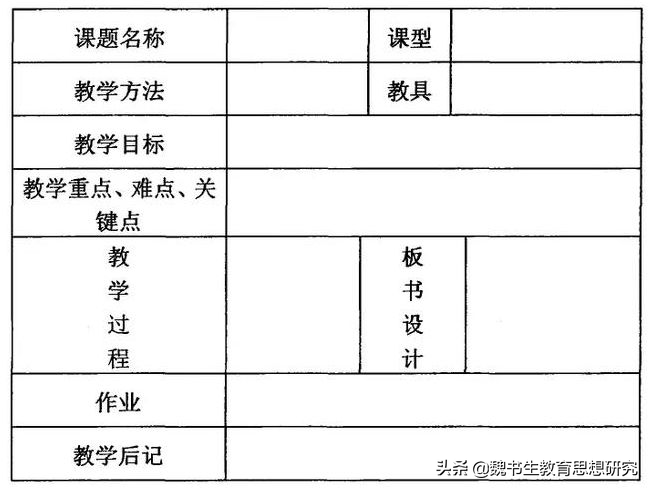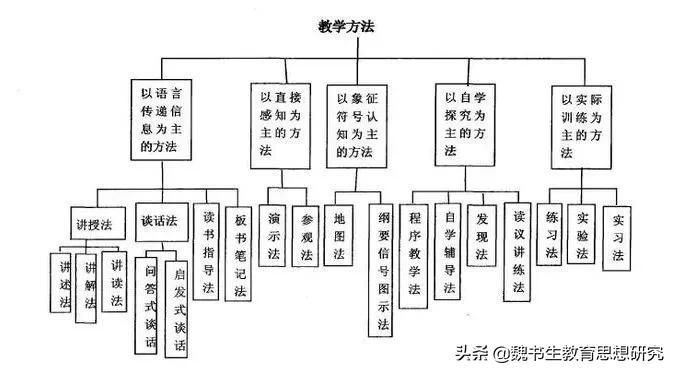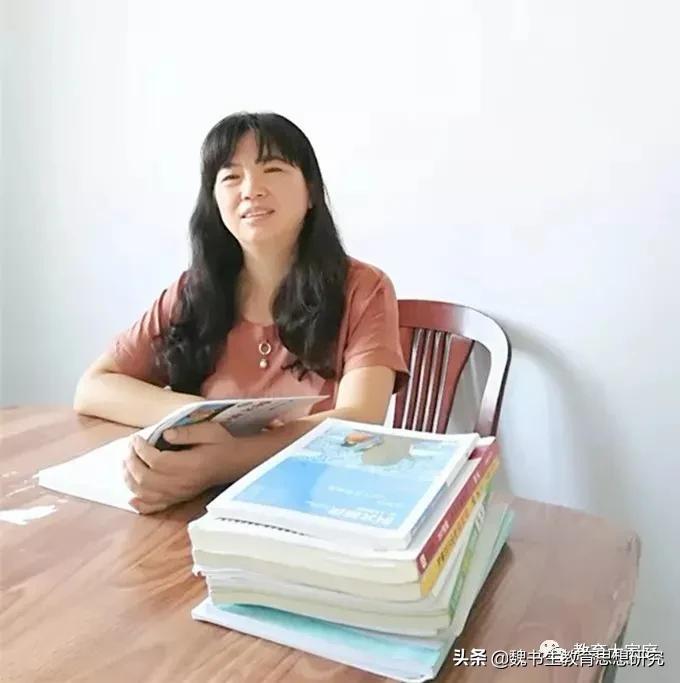one What are the forms of writing lesson plans?
LiteralYes, all content is displayed in text form, and it can be divided into two types: brief case and detailed case.Topic name, teaching objectives, important teaching difficulties, intuitive teaching aids, board book plan, class processIt consists of six parts. Tabular formatOne of the most common forms of lesson plans in today's teaching work, the general form of the table is as follows:

two Components of the lesson plan
Teaching goals, Mainly refers to the teaching task to be completed in this lesson, that is, the class time goal.
Teaching method, Refers to the teaching method used by the teacher in the teaching process of this lesson.Subject type, That is, the type of course.Teaching aids, Refers to what teaching tools teachers should use to promote teaching, thereby improving the quality and effectiveness of teaching.Teaching process, Including teaching steps and time allocation, the arrangement of teaching content and the specific use of teaching methods.Board book design, It must be concise and clear, so that people can understand it at a glance, and it is convenient for students to take notes.Job settings, That is, to feedback whether the students have mastered the knowledge they have learned in the classroom, and to test it in the form of homework.Postscript to Teaching, Including teachers' after-school summaries, highlights and shortcomings in teaching, and teaching inspiration. The main purpose is to help teachers evaluate their teaching effectiveness in a timely manner and improve their teaching level.
1Writing of teaching goals
Teaching goals are goals that both teachers and students pursue together. For teachers, they are teaching goals, and for students, they are the ultimate behavioral changes in teaching activities.
At the same time, the teaching goal is also an expected result, that is, the result produced after the teaching activity. Scholar Wang Xianyao pointed out that the teaching goals need to be clear, which mainly include three aspects,Knowledge mastery point, skill training point, moral education penetration point. Teaching goals can be divided into three categories, includingCurriculum goals, unit goals, and class time goals; When writing, the target level needs to be analyzed and considered according to different categories. For lesson plans, they are customized for class hours, so they need to focus on the formulation of goals. Class time goals are the most basic of teaching goals. When setting class time goals, they should fully realize the four aspects of comprehensive content, clear levels, moderate requirements, and specific measurable. who, what, how, whyFour dimensions are analyzed.whoTo analyze the level of students taught and the level of knowledge mastery, etc.;whatIt is the task that needs to be completed in this lesson, the main difficulties, what kind of knowledge and skills to acquire, and what effect to achieve.;howWhat teaching processes and methods are used to complete teaching tasks?;whyIt is the reason for teaching design. Only by considering all aspects of factors comprehensively can appropriate teaching goals and reasonable teaching steps be formulated.
2Writing of teaching methodsTeaching methods are based on teaching goals. They refer to teaching methods and methods. They are a general term for completing teaching tasks. Their methods are also diverse. The specific teaching methods are as follows:

So how do so many teaching methods choose the most suitable for classroom teaching? You can refer to the following points of basis: First of all, according to the overall control of the teaching goals, to choose the appropriate teaching method. Since it is mostly oriented to primary and middle school students, you can choose intuitive teaching methods such as graphic language. Secondly, the choice of teaching methods needs to be designed according to the content characteristics of the teaching materials, and at the same time, the teachers' own teaching style and characteristics need to be considered. They cannot pursue novelty and sacrifice their own to the end; finally, teaching time and efficiency should also be fully considered, and good teaching methods will make classroom teaching more effective with half the effort.
3Choice of teaching aidsAmong the many teaching aids, we can divide teaching aids into two categories: traditional teaching aids and modern teaching aids. Traditional teaching aids include cards, books, icons, ornaments, physical objects, newspapers, etc.;
Modern teaching aids can be divided into visual, auditory, visual and auditory, and multimedia categories. Because of the development of science and technology, more and more efficient modern education has also emerged. One thing that needs to be clear here,Teaching aids are prepared for teaching activities, and teaching knowledge in teaching activities is the most important purpose. Teachers let students spend five minutes to write about the uncivilized phenomena they have seen. After the students have written it, the teachers use modern teaching aids to upload the physical objects handwritten by the students to the multimedia in real time and become electronic versions for teaching and teaching... We have to think about the purpose of such behavior.What is it; if you change the form and directly let students hold the document in their hands and explain their ideas and ideas about the content they have written in the classroom, will it enhance the classroom experience and strengthen the practical significance of teaching? The use of teaching aids should fully serve teaching, give full play to the role and advantages of teaching aids, and enhance the learning experience.
4Teaching activity processThe teaching process, that is, the activity process in which the teacher's teaching and the student's learning are unified with each other, is also the activity process in which the teacher guides the student's learning.
The process of teaching activities shall be based on the characteristics of the teaching object. The process of teaching activities should be based on the nature of the teaching goals. For different teaching goals, teachers should design different teaching activities.
5Board book designBoard book, understood from a dynamic perspective, is a way of language activity in which teachers write words and symbols on the blackboard during class to convey teaching content and educate people. Board book is also known as the written language of teaching.;
Understood from a static perspective, it is a general term for the teaching information displayed by teachers using blackboards, concise words, symbols, tables, etc. to help students understand knowledge in the teaching process. In general, the board book is the basis of the entire course. The quality of the board book design is inseparable from the teacher's overall teaching arrangement and teaching understanding, and comprehensively tests the teacher's personal level.
6Job settingsSubject work can promote students' understanding and mastery of knowledge, and it is also conducive to students to transform the knowledge they have learned into skills and improve their ability to use knowledge to analyze and solve problems.
For teachers, homework is conducive to teachers to understand the teaching effect, obtain feedback information, and regulate this in a timely manner, which is more conducive to achieving teaching goals.
7Postscript to Teaching
The last content of the lesson plan writing is the afterword of the teaching. This content is mainly written after teaching,It is the teacher who self-evaluates his own teaching, summarizes and reflects on the highlights and shortcomings in teaching. Instantaneous inspiration in the course of classroom teaching, non-logical play, is valuable. It is often an important factor in determining the effectiveness of the classroom. Teachers should grasp the instantaneous inspiration that appears in the classroom in a timely manner and record it in time for the revision of the speech. After the course is completed, summarize and improve the lesson plan. After a semester of teaching, teachers will find that their lesson plans are gradually enriched and “blooming”. The teaching postscript should generally include three aspects of content:A record of successful experience, a record of insufficient teaching, and a record of teaching inspiration. After teaching, teachers should make objective analysis and evaluation of their own teaching, and summarize the highlights and successes of this lesson. For example, the design of teaching activities is reasonable, the use of teaching methods is appropriate, and the teaching methods are fascinating. Moreover, classroom teaching is a bilateral interaction between teachers and students, which is more accidental. Therefore, it is inevitable that there will be some mistakes and shortcomings in classroom teaching. Teachers should summarize the shortcomings after class and learn lessons so that they can better deal with various problems in the teaching process. Sometimes, teachers may also have a good idea in the teaching process, such as practicing words and suddenly thinking of novel teaching activities, then they should be recorded in time after class to prepare for future teaching.
three Five principles for writing lesson plans
1ScientificThe ideological views, content knowledge and teaching methods embodied by teachers in the writing of the plan should be accurate, scientific and effective. In order to ensure the scientific nature, teachers should go through a process of understanding, deepening and integration of teaching materials. To understand is to analyze the basic ideas and concepts of teaching materials; to be deep is to delve into teaching materials and sort out the vertical and horizontal connections; to be integrated is to integrate the teacher's educational philosophy with the ideological and scientific nature of teaching materials.
2PracticalityThe purpose of teachers writing lesson plans is for classroom teaching, so lesson plans must be practical. When writing lesson plans, teachers must overcome formalism and write personalized lesson plans based on their own teaching ideas and teaching styles.
3TargetedTeachers write lesson plans not only to reflect the problem of how teachers teach, but also to focus on students. They must start from the perspective of students and have a guiding effect, reflecting the teacher-led and student-subject teaching ideas.
4DevelopmentalAvoid plagiarism and copying in the writing of lesson plans, because excellent lesson plans may have very successful effects on others, but they may not be applicable to yourself. The times are developing, knowledge is constantly deepening, students are constantly changing, and teachers must always innovate and revise their own lesson plans.
5CreativityTeachers should reflect the idea of teaching reform in the writing of lesson plans. For example, the following questions can be reflected in the lesson plan: how to mobilize the enthusiasm of students, how to strengthen the ideological nature of teaching, how to impart basic knowledge more scientifically, how to reduce the burden of schoolwork, and so on.



Leave a Reply